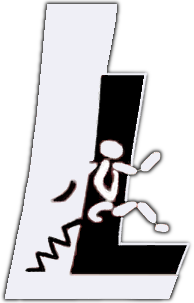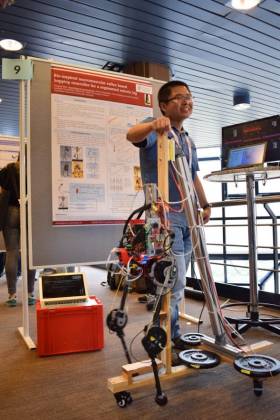Hybrid Electric-Pneumatic Actuator (EPA) for legged locomotion
 A better understanding of how actuator design supports locomotor function may
help design and develop novel and more functional powered assistive or robotic legged
systems. Legged locomotion can be described as a composition of locomotor
sub-functions, namely axial leg function, leg swinging and balancing.
A better understanding of how actuator design supports locomotor function may
help design and develop novel and more functional powered assistive or robotic legged
systems. Legged locomotion can be described as a composition of locomotor
sub-functions, namely axial leg function, leg swinging and balancing.
In this project, we focus on the axial leg function (e.g., spring-like hopping) based on a novel concept of a hybrid electric-pneumatic actuator (EPA). This principal locomotor sub-function determines the movement of the body center of mass. We will design and manufacture EPA prototypes as enhanced variable impedance actuators (VIA). In contrast to other VIAs, the EPA provides not only adaptable compliance (e.g. an adjustable spring) but with the pneumatic artificial muscle (PAM) also an additional powerful actuator with muscle-like properties, which can be arranged in different configurations (e.g., in series or parallel) to the electric motor (EM). This novel hybrid actuator shares the advantages of EM and PAM combining precise control with compliant energy storage required for efficient, robust, and versatile human-like leg motions via simple control laws.
Based on human experiments, the EPA design will be optimized to minimize energy consumption and maximize robustness against perturbations within a desired operational range. We consider human hopping in place as a simple movement concentrating on the axial leg function.
A simulation model of human muscle-skeletal function reproducing human hopping experiment results will be used to identify the objective function for the biological actuators (muscles) through “inverse optimal control”. This biologically inspired cost function will then help us to identify the most appropriate EPA actuator design. A robotic setup of the MARCO-2 hopping robot will be equipped with EPA to demonstrate and evaluate the actuator design and control. Based on its mechanical properties and its flexible arrangement in multi-segment-systems, the EPA provides a novel actuator that mimics human muscle function and is able to mechanically adapt to different gaits and conditions (e.g. locomotion speed). Preliminary experimental and simulation studies in our group show evidence of the expected advantages of adding PAM to EM. We expect that only a limited exchange of sensory information between the different locomotor sub-function controllers will be required enabling the envisioned modular architecture of the locomotor control system. With EPA technology, new versatile, efficient and robust locomotor systems for a wide range of applications can be designed.
You can find the short version of the proposal here
Demonstrations:
AMAM 2019 conference (EPFL)
Related videos:
Experiments: the role of Parallel PAMs at knee in EPA-hopper-1
Detials of this experiment is reported in a recent publication in IEEE/ASME Transactions on Mechatronics
Experiments: The role of Soleus and Gastrocnemius muscles in stability and performance of EPA-hoppe-2
Concerted Control Concept (Dynamic Walking 2019)
Modular Control of Legged Locomotion - Concepts, Models and Applications (Dynamic Walking 2019)
Dissemination:
Book and book chapters
- Sharbafi, M. A., Naseri, A., Seyfarth, A., & Grimmer, M. (2020). Neural control in prostheses and exoskeletons. In Powered Prostheses (pp. 153-178). Academic Press DOI.
- Beckerle. P, Sharbafi, M. A., Verstraten. T, Pott. P, Seyfarth. (2020) Novel bioinspired actuator designs for robotics, Springer-Nature.
Journal Papers
- Sharbafi, M. A., Yazdanpanah, M. J., Ahmadabadi, M. N., & Seyfarth, A. (2021). Parallel Compliance Design for Increasing Robustness and Efficiency in Legged Locomotion—theoretical background and applications. IEEE/ASME Transactions on Mechatronics, 26(1), pp. 335-346. DOI.
- Zhao, G., Szymanski, F., & Seyfarth, A. (2020). Bio-inspired neuromuscular reflex based hopping controller for a segmented robotic leg. Bioinspiration & Biomimetics, 15(2). pp. 026007. DOI.
- Schumacher, C., Sharbafi, M. A., Seyfarth, A. & Rode, C. (2020). Biarticular muscles in light of template models, experiments and robotics: a review. J. R. Soc. Interface, 17. DOI
- Sharbafi, M. A., Naseri, A., Seyfarth, A., & Grimmer, M (2020). Neural control in prostheses and exoskeletons. In Powered Prostheses (pp. 153-178), Elsevier. DOI.
- Barazesh, H., Sharbafi, M. A. (2020) A biarticular passive exosuit to support balance control can reduce metabolic cost of walking. Bioinspiration & Biomimetics, 15(3), pp. 036009. DOI.
- Firouzi, V., Davoodi, A., Bahrami, F., & Sharbafi, M. A. (2020). From a biological template model to gait assistance with an exosuit. BioRxiv DOI.
- Naseri, A.; Mohammadi Moghaddam, M.; Gharini, M.; Sharbafi, M. A. (2020). Novel Adjustable Damper Design for a Hybrid Passive Ankle Prosthesis. Actuators 9(3), DOI.
- Sharbafi, M. A., Yazdanpanah, M. J., Nili Ahmadabadi. M., & Seyfarth. A., Parallel compliance design for increasing robustness and efficiency in legged locomotion – proof of concept. IEEE Transactions on Mechatronics, 24 (4), 1541 - 1552, IEEE
- Davoodi, A., Mohseni, O., Seyfarth, A., Sharbafi, M. A., From template to anchors: transfer of virtual pendulum posture control balance template to adaptive neuromuscular gait model increases walking stability. Royal Society open science, 6(3) Royal Society
- Oehlke, O., Beckerle, P., Seyfarth, A., Sharbafi, M. A., Human-like hopping in machines; Feedback- versus feed-forward-controlled motions. Biological Cybernetics, 113(3) Springer
- Sarmadi, A., Schumacher, C., Seyfarth, A., & Sharbafi, M. A., Concerted control of stance and balance locomotor subfunctions-Leg force as a conductor. IEEE Transactions on Medical Robotics and Bionics, 49-57 IEEE
- Sharbafi, M. A., Barazesh, H., Iranikhah, M., & Seyfarth, A, Leg force control through biarticular muscles for human walking assistance. Frontiers in neurorobotics, 12, DOI
- Sharbafi M. A., Shin H., Zhao G., Hosoda K. and Seyfarth A., Electric-Pneumatic Actuator: A New Muscle for Locomotion. Actuators 2017, 6(4), 30; DOI
Conference Papers
- Mohseni. O, Gagey. F, Zhao. G, Seyfarth. A, & Sharbafi, M. A. (2020), How Far Are Pneumatic Artificial Muscles from Biological Muscles?, IEEE International Conference on Robotics and Automation (ICRA), pdf.
- Firouzi, V., Seyfarth, A., & Sharbafi, M. A. (2019, November). TIP Model: A Combination of Unstable Subsystems for Lateral Balance in Walking. In 2019 IEEE/RSJ International Conference on Intelligent Robots and Systems (IROS) (pp. 476-482). pdf.
- Anand, A. S., Zhao, G., Roth, H., & Seyfarth, A. (2019, October). A deep reinforcement learning based approach towards generating human walking behavior with a neuromuscular model. In 2019 IEEE-RAS 19th International Conference on Humanoid Robots (Humanoids) (pp. 537-543). pdf.
- Firouzi, V., Seyfarth, A., & Sharbafi, M. A. (2019). Does VPP exist in lateral balancing?. In 9ᵗʰ International Symposium on Adaptive Motion of Animals and Machines (AMAM 2019), EPFL, Switzerland pdf.
- Sharbafi, M. A. Seyfarth, A. (2019) Concerted control approach with leg force as a conductor. (2019). Dynamic Walking, Canmore, Canada,sharbafi2019.pdf Presentation video in youtube.
- Seyfarth, A., Sharbafi, M. A., Zhao, G., & Schumacher, C. (2018, October). Modular Composition of Human Gaits Through Locomotor Subfunctions and Sensor-Motor-Maps. In International Symposium on Wearable Robotics (pp. 339-343). Springer, Cham pdf.
- Naseri. A., Grimmer, M., Seyfarth, A. & Sharbafi, M. A., Template-based control of prosthetic feet. CYBATHLON PROSTHESIS SERIES & SYMPOSIUM ON ASSISTIVE AND WEARABLE ROBOTICS (AsWeR19)
- Sharbafi, M. A., Zadravec, M., Matjačić, Z, & Seyfarth, A. A 3D Template Model for Healthy and Impaired Walking. IEEE/RSJ International Conference on Intelligent Robots and Systems (IROS). IEEE, 2018
- Sarmadi, A., Sharbafi, M. A., Schumacher, C., & Seyfarth, A.Force-Feedback Coordinates Stance and Balance Locomotor Subfunctions in Hopping. 2018 7th IEEE International Conference on Biomedical Robotics and Biomechatronics (Biorob). IEEE, 2018
Organized workshops:
- Novel bioinspired actuator designs for robotics (BioAct)
This workshop was held in the BioRob 2018 conference in Enschede, the Netherlands. Please see BioAct Workshop at BioRob 2018 for details.
- What should we expect from passive exoskeletons?
This workshop is organized as a special session in WeRob/WearRaCon 2020 conference. Please see Passive Exoskeletons Workshop at WeRob/WearRaCon 2020 for detials.










